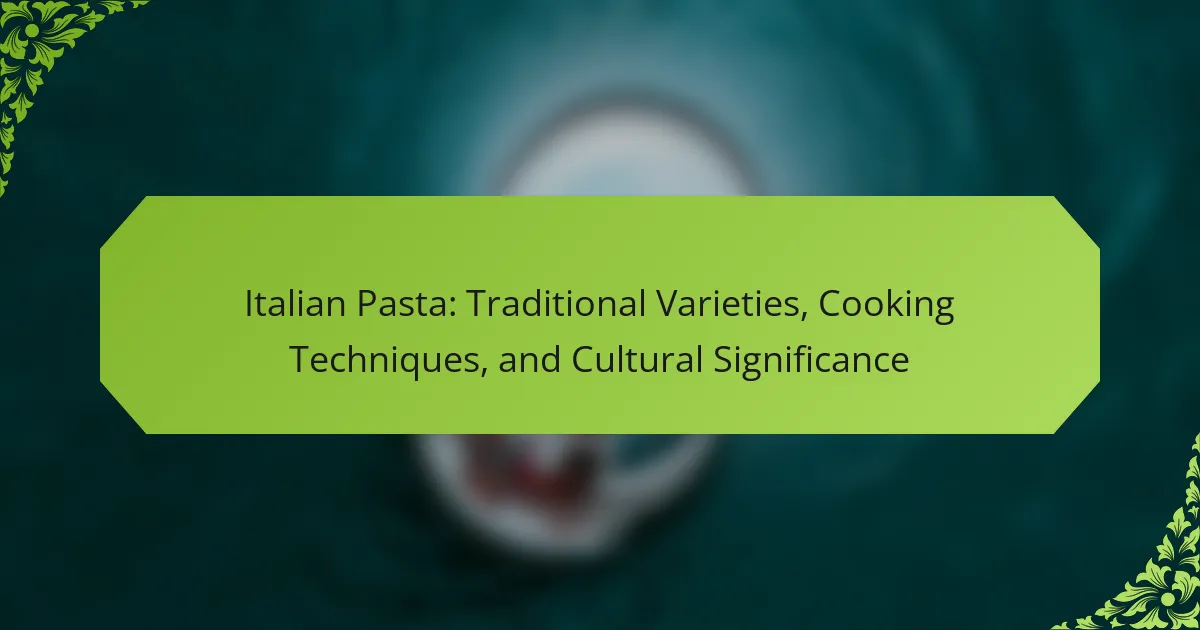Italian pasta offers a diverse array of traditional varieties, each with distinct shapes and culinary uses. Explore the essential cooking techniques that enhance flavor and texture. Discover the cultural significance of pasta in Italy, reflecting regional ingredients and family traditions. Learn about unique dishes that showcase local specialties and avoid common cooking mistakes for optimal results.

What are the traditional varieties of Italian pasta?
Italian pasta encompasses various traditional varieties, each with unique shapes and uses. Common types include spaghetti, penne, fettuccine, and lasagna. These varieties often reflect regional ingredients and cooking methods, contributing to Italy’s rich culinary heritage. Spaghetti is long and thin, ideal for light sauces, while penne’s tubular shape holds thicker sauces well. Fettuccine, flat and wide, pairs beautifully with creamy sauces. Lasagna consists of layered sheets, often baked with cheese and meat or vegetables. Each type serves a distinct purpose in Italian cuisine, showcasing the diversity and cultural significance of pasta.
Which regional differences influence pasta types?
Regional differences significantly influence pasta types, shaping their ingredients and shapes. Northern Italy favors creamy sauces and egg-based pastas like tagliatelle, while Southern Italy emphasizes tomato-based sauces and durum wheat pastas like orecchiette. Each region’s climate and agricultural practices contribute to these variations. For instance, the wheat quality in the South supports robust, hearty pastas, whereas the North’s cooler climate encourages the use of eggs for richer textures. Cultural traditions also dictate specific pasta shapes, such as the stuffed varieties in Emilia-Romagna. These regional distinctions highlight Italy’s diverse culinary landscape.
How do ingredients affect pasta classification?
Ingredients significantly influence pasta classification by determining texture, flavor, and cooking methods. The primary ingredient, durum wheat semolina, creates firmer pasta, while other flours, like whole wheat or rice, yield different characteristics. Unique attributes include the use of eggs in fresh pasta, which enhances richness and elasticity. Rare ingredients, such as squid ink, introduce distinctive colors and flavors, further diversifying pasta varieties. Understanding these factors is essential for appreciating traditional Italian pasta’s cultural significance and culinary applications.
What are the most popular pasta shapes and their uses?
The most popular pasta shapes include spaghetti, penne, fusilli, and farfalle, each serving distinct culinary purposes. Spaghetti is ideal for light sauces, while penne holds thicker sauces well. Fusilli’s spiral shape captures ingredients, making it great for salads. Farfalle, resembling butterflies, is often used in both pasta salads and creamy dishes. Each shape enhances the overall dining experience by complementing different flavors and textures.
Which pasta varieties are best for specific sauces?
Certain pasta varieties pair best with specific sauces. For example, long, thin pastas like spaghetti complement light olive oil or tomato-based sauces. Short, tubular pastas such as penne are ideal for thicker, cream-based sauces. Flat noodles like fettuccine work well with rich sauces like Alfredo.
Here’s a concise overview of pasta and sauce pairings:
| Pasta Variety | Best Sauce Type |
|—————–|————————–|
| Spaghetti | Light olive oil, tomato |
| Penne | Cream-based |
| Fettuccine | Alfredo |
| Linguine | Clam sauce |
| Farfalle | Pesto |
| Orecchiette | Sausage or broccoli sauce |

How do cooking techniques impact pasta quality?
Cooking techniques significantly influence pasta quality by affecting texture and flavor. Methods such as boiling, sautéing, and baking each yield distinct results. For example, al dente pasta retains firmness, enhancing its mouthfeel. Traditional Italian techniques emphasize timing and temperature control, ensuring optimal absorption of sauces. The choice of cooking method can also enhance the nutritional profile of the dish, impacting overall satisfaction.
What are the essential steps for cooking pasta perfectly?
To cook pasta perfectly, follow these essential steps: use ample water, bring it to a rolling boil, add salt, and cook until al dente.
Start by filling a large pot with water, using about 4-6 quarts per pound of pasta. Bring the water to a vigorous boil before adding salt; this enhances flavor and helps prevent sticking. Once the pasta is added, stir occasionally to ensure even cooking. Follow the package instructions for cooking time, but check for al dente texture a minute or two before the recommended time. Drain the pasta, reserving some cooking water for sauces if needed.
These techniques reflect traditional Italian culinary practices, ensuring that pasta maintains its integrity and flavor.
How do different cooking methods alter texture and flavor?
Different cooking methods significantly alter the texture and flavor of Italian pasta. Boiling creates a firm and springy texture, while baking results in a softer, more cohesive dish. Sautéing enhances flavor through caramelization, adding depth. Steaming preserves nutrients and maintains a delicate texture. Each method influences the final taste and mouthfeel, showcasing the versatility of pasta in Italian cuisine.
What role does timing play in pasta preparation?
Timing is crucial in pasta preparation as it affects texture, flavor, and overall quality. Cooking pasta for the right duration ensures it reaches the ideal al dente state, which is a hallmark of traditional Italian cuisine. Overcooking can lead to a mushy texture, while undercooking may result in a chewy bite.
Additionally, the timing of adding sauce or ingredients can enhance flavor absorption and integration. For example, combining pasta with sauce just before serving allows the flavors to meld without losing the pasta’s integrity.
Cultural significance also plays a role; Italians often emphasize the importance of precise timing in cooking to honor traditional recipes. This attention to timing reflects the deep respect for culinary heritage within Italian culture.

Why is pasta significant in Italian culture?
Pasta holds deep significance in Italian culture as a symbol of tradition and community. It represents regional diversity, with each area boasting unique varieties and recipes. For example, pasta shapes like orecchiette from Puglia or trofie from Liguria highlight local ingredients and customs. Cooking techniques, such as al dente preparation, emphasize the importance of texture and flavor. Additionally, pasta is central to family gatherings and celebrations, fostering connections among generations. Its cultural significance is further reflected in Italian cuisine’s global influence, showcasing pasta as an enduring culinary heritage.
How does pasta feature in traditional Italian celebrations?
Pasta is central to traditional Italian celebrations, symbolizing unity and abundance. Various pasta dishes are prepared for holidays and family gatherings, showcasing regional varieties. For instance, lasagna is popular during Christmas, while orecchiette often features in Easter meals. Each dish tells a story of cultural heritage and family traditions, reinforcing the importance of togetherness in Italian culture.
What are the cultural practices surrounding pasta meals?
Italian pasta meals are deeply rooted in cultural practices that emphasize family, tradition, and regional diversity. Meals often feature communal dining, where families gather to share dishes, highlighting the significance of togetherness.
Traditional pasta varieties vary by region, each showcasing unique ingredients and preparation methods. For instance, Northern Italy favors creamy sauces, while Southern Italy embraces tomato-based sauces.
Cooking techniques also reflect cultural heritage, with methods passed down through generations. Fresh pasta is often made by hand, emphasizing craftsmanship.
Pasta meals are typically accompanied by specific rituals, such as serving in courses and pairing with regional wines, enhancing the dining experience. These practices not only celebrate Italian cuisine but also foster a sense of identity and continuity within families and communities.
How has pasta influenced Italian identity over time?
Italian pasta has profoundly shaped Italian identity through its regional diversity and cultural significance. Different varieties, such as spaghetti and penne, represent local traditions and ingredients. Pasta is central to family gatherings, celebrations, and daily meals, symbolizing unity and heritage. Over time, it has evolved from a simple staple to a symbol of Italian craftsmanship and culinary pride, influencing both national and global perceptions of Italian culture.

Which unique pasta dishes showcase regional specialties?
Unique pasta dishes that showcase regional specialties include Pesto alla Genovese from Liguria, Orecchiette con Cime di Rapa from Puglia, and Spaghetti alle Vongole from Campania. Each dish highlights local ingredients and cooking methods. For instance, Pesto alla Genovese uses fresh basil, pine nuts, and Parmesan, reflecting Liguria’s coastal agriculture. Orecchiette, shaped like small ears, is traditionally paired with broccoli rabe, emphasizing Puglia’s robust flavors. Spaghetti alle Vongole features clams, showcasing Campania’s seafood heritage. These dishes not only represent their regions but also embody Italy’s rich culinary traditions.
What are the characteristics of handmade pasta compared to industrial varieties?
Handmade pasta is typically denser and has a more robust flavor compared to industrial varieties. It is often made with high-quality ingredients and traditional methods, resulting in unique textures and shapes. Handmade pasta generally retains more moisture and can be more absorbent, enhancing the overall dish. In contrast, industrial pasta is mass-produced, often using lower-quality flour and additives, which can affect taste and texture. The cultural significance of handmade pasta ties closely to regional traditions and family recipes, making it a unique culinary experience.
How do local ingredients enhance pasta dishes?
Local ingredients significantly enhance pasta dishes by providing fresh flavors and cultural authenticity. Using regional produce, meats, and cheeses creates unique profiles that reflect local traditions. For example, tomatoes from San Marzano elevate sauces with their sweetness, while Parmigiano-Reggiano from Emilia-Romagna adds depth. This connection to local agriculture not only supports farmers but also preserves culinary heritage, making each dish a celebration of its origin.

What are the common mistakes to avoid when cooking pasta?
To avoid common mistakes when cooking pasta, ensure proper water-to-pasta ratio, avoid overcooking, and refrain from rinsing after draining. Using enough salt in the boiling water enhances flavor, while stirring occasionally prevents sticking. Additionally, always reserve some pasta water for sauce adjustments.
What expert tips can help improve pasta preparation?
To improve pasta preparation, focus on selecting high-quality ingredients and precise cooking techniques. Use fresh pasta for a superior texture, and always salt your water generously to enhance flavor.
1. Choose the right pasta shape for your sauce; thicker sauces pair well with robust shapes like rigatoni.
2. Cook pasta al dente to maintain texture and prevent mushiness; this enhances the overall dish.
3. Reserve some pasta cooking water; it can be added to sauces for better consistency and flavor integration.
4. Toss pasta with sauce immediately after cooking; this helps the pasta absorb the sauce’s flavors effectively.
How can understanding pasta types enhance meal planning?
Understanding pasta types enhances meal planning by allowing for tailored dishes that complement flavors and textures. Different pasta shapes and sizes pair uniquely with sauces, impacting the overall dining experience. For instance, long noodles like spaghetti are ideal for lighter sauces, while short pasta such as penne holds thicker sauces better. Additionally, knowing cooking techniques for each variety ensures optimal texture and taste, contributing to a successful meal. Embracing the cultural significance of pasta types can inspire creativity and authenticity in Italian cuisine, enriching the planning process.



